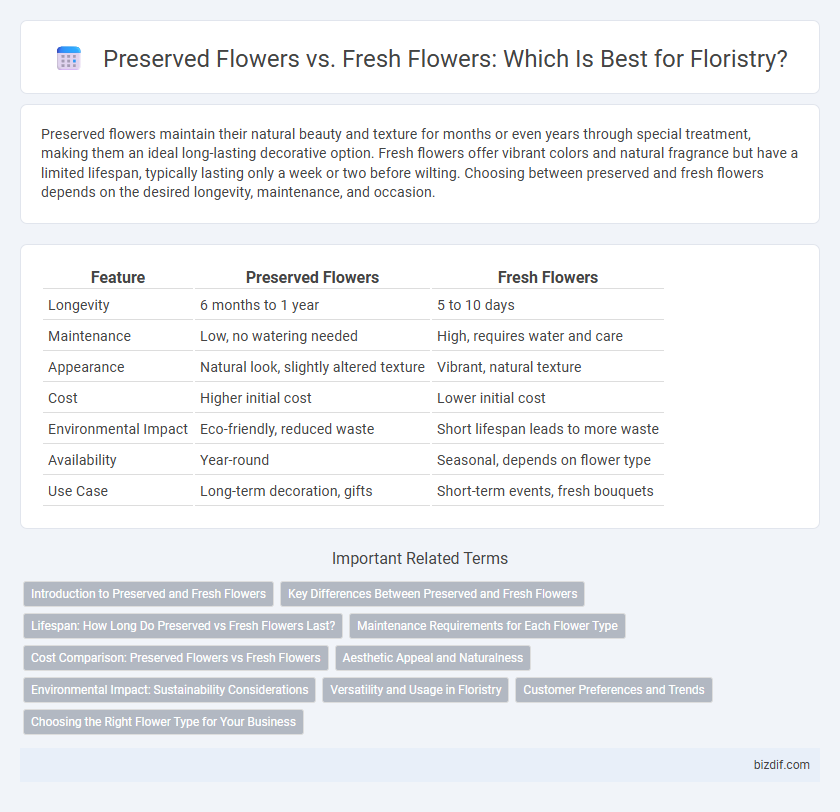Preserved flowers maintain their natural beauty and texture for months or even years through special treatment, making them an ideal long-lasting decorative option. Fresh flowers offer vibrant colors and natural fragrance but have a limited lifespan, typically lasting only a week or two before wilting. Choosing between preserved and fresh flowers depends on the desired longevity, maintenance, and occasion.
Table of Comparison
| Feature | Preserved Flowers | Fresh Flowers |
|---|---|---|
| Longevity | 6 months to 1 year | 5 to 10 days |
| Maintenance | Low, no watering needed | High, requires water and care |
| Appearance | Natural look, slightly altered texture | Vibrant, natural texture |
| Cost | Higher initial cost | Lower initial cost |
| Environmental Impact | Eco-friendly, reduced waste | Short lifespan leads to more waste |
| Availability | Year-round | Seasonal, depends on flower type |
| Use Case | Long-term decoration, gifts | Short-term events, fresh bouquets |
Introduction to Preserved and Fresh Flowers
Preserved flowers undergo a special treatment process that maintains their natural appearance and texture for months or even years without water, making them an eco-friendly and low-maintenance alternative to fresh flowers. Fresh flowers, harvested daily, offer vibrant colors and natural fragrance but have a limited lifespan, typically lasting only a week with proper care. The choice between preserved and fresh flowers depends on factors like longevity requirements, intended use, and maintenance preferences in floral design.
Key Differences Between Preserved and Fresh Flowers
Preserved flowers undergo a dehydration and stabilization process using glycerin and other solutions to maintain their natural appearance and texture for months or even years, whereas fresh flowers have a limited lifespan of a few days to weeks. Fresh flowers provide vibrant color and fragrance but require water, specific temperature conditions, and immediate care to stay alive. In contrast, preserved flowers offer long-lasting beauty with minimal maintenance, making them ideal for lasting floral arrangements and decorative purposes.
Lifespan: How Long Do Preserved vs Fresh Flowers Last?
Preserved flowers last significantly longer than fresh flowers, typically maintaining their appearance for 6 months to 3 years with proper care, while fresh flowers generally last only 5 to 12 days. The preservation process involves treating flowers with special solutions that replace natural sap, preventing decay and moisture loss. This extended lifespan makes preserved flowers a popular choice for long-term decorative arrangements and keepsakes.
Maintenance Requirements for Each Flower Type
Preserved flowers require minimal maintenance, needing only occasional dusting and avoiding direct sunlight to retain their vibrant appearance for months or even years. Fresh flowers demand regular watering, trimming, and ideal environmental conditions such as appropriate humidity and temperature to prolong their natural lifespan. The maintenance disparity between preserved and fresh flowers makes preserved varieties a low-effort, long-lasting alternative for floral arrangements.
Cost Comparison: Preserved Flowers vs Fresh Flowers
Preserved flowers generally cost more upfront than fresh flowers due to the specialized preservation process that extends their lifespan up to several months or years. Fresh flowers have a lower initial price but require frequent replacement, resulting in higher long-term expenses for events or home decor. Choosing preserved flowers offers a cost-effective solution over time by eliminating the need for continual purchases and reducing waste.
Aesthetic Appeal and Naturalness
Preserved flowers maintain their vibrant colors and delicate textures for months, offering a long-lasting aesthetic appeal unlike fresh flowers, which wilt and fade within days. The naturalness of fresh flowers is undeniable, providing the authentic fragrance and sensory experience that preserved flowers lack due to the preservation process. Florists often recommend preserved flowers for stable decor, while fresh flowers remain the top choice for events demanding a true-to-nature ambiance.
Environmental Impact: Sustainability Considerations
Preserved flowers offer a sustainable alternative to fresh flowers by reducing water consumption and minimizing waste through extended longevity, often lasting months to years without needing replacement. Fresh flowers require significant resources, including frequent irrigation, pesticide use, and transportation emissions, contributing to larger carbon footprints and greater environmental strain. Choosing preserved flowers supports eco-friendly floristry practices by decreasing the demand for continuous cultivation and reducing overall resource depletion.
Versatility and Usage in Floristry
Preserved flowers offer extended versatility in floristry by maintaining vibrant colors and natural textures for months, ideal for long-lasting arrangements and intricate designs. Fresh flowers provide dynamic options with their natural fragrance and seasonal variety, making them perfect for events that prioritize immediate visual impact and scent. Florists often choose preserved flowers for sustainable, durable decor while fresh flowers remain essential for traditional bouquets and floral displays requiring natural freshness.
Customer Preferences and Trends
Preserved flowers maintain their vibrant colors and delicate textures for months, appealing to customers seeking long-lasting floral arrangements with minimal upkeep. Fresh flowers attract buyers who prioritize natural fragrance and seasonal variety, often favoring them for special occasions and events. Current trends indicate a rising preference for preserved flowers in home decor and sustainable gifting, driven by eco-conscious consumers valuing durability and reduced waste.
Choosing the Right Flower Type for Your Business
Choosing the right flower type for your floristry business depends on factors such as longevity, maintenance, and customer preferences. Preserved flowers offer extended shelf life, minimal care, and consistent appearance, making them ideal for upscale events and long-term displays, while fresh flowers provide vibrant colors and natural fragrance that attract clients seeking traditional and seasonal arrangements. Evaluating your target market, budget, and intended use will guide the optimal selection between preserved and fresh flowers to maximize customer satisfaction and profitability.
Preserved flowers vs Fresh flowers Infographic

 bizdif.com
bizdif.com